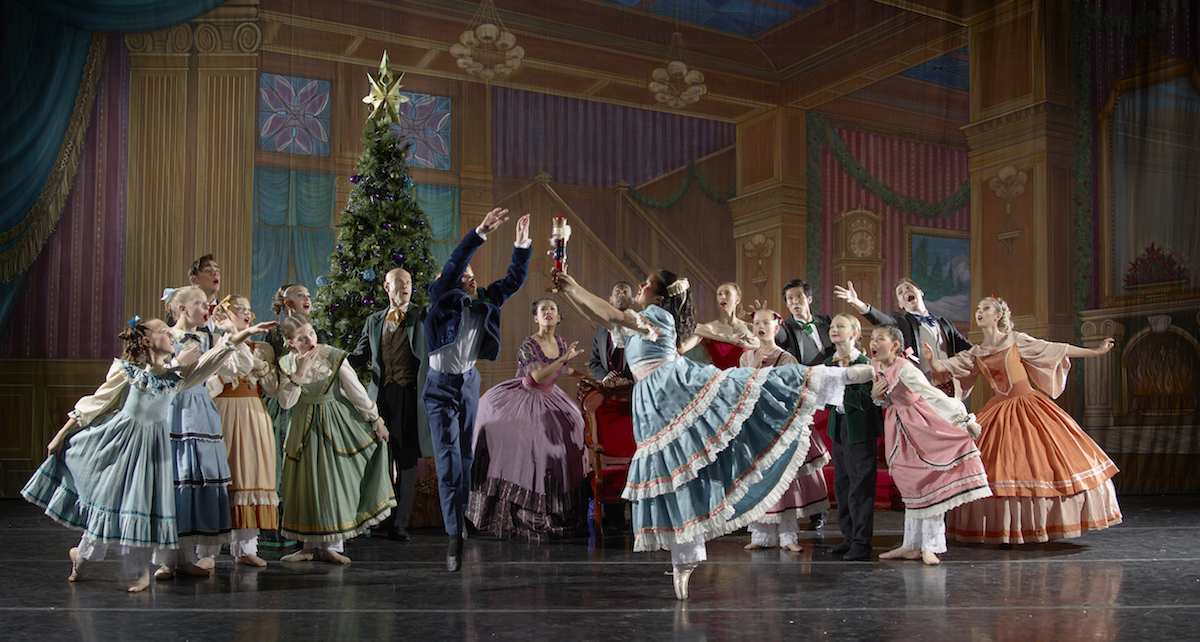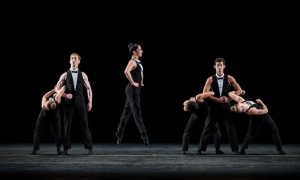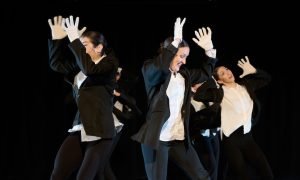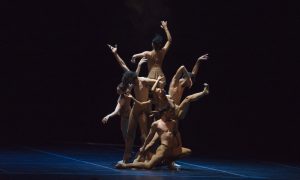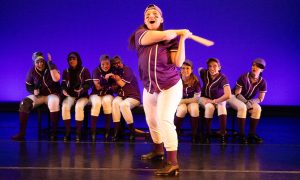The Cutler Majestic Theatre, Boston, Massachusetts.
December 2, 2016.
There is a certain visual pleasure in something incredibly bright and eye-catching — what some might call flashy. There’s another kind in something aesthetically harmonious, understated and classically elegant. We’re in an age of Snapchat, Instagram, Tweets, mobile advertising and other flashes of visuals vying for our attention. That makes experiencing something more like the latter refreshing, comforting and even healing. This season, José Mateo Ballet Theatre’s The Nutcracker offered that elegance and aesthetic harmony.
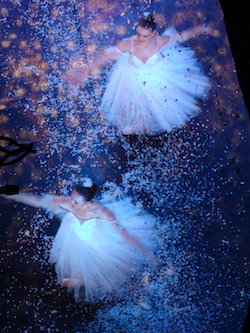
José Mateo Ballet Theatre in ‘The Nutcracker’. Photo by Gary Sloan.
This stylistic offering began with a very intriguing, very innovative choreographic take on the show’s opening. Clara (Cecilia Zevallos) moved around dancers each holding a long, curtain-like fabric — at times enclosing themselves inside of their fabrics, to all together create a large piece of furniture. Clara moved with a grace, poise and technical command quite impressive for a young dancer. Another creative, interesting addition to the show’s main structure was Drosselmeyer wrestling the animated Columbine (Magdalena Gyftopoulos) and Harlequin (Junichi Fukuda) into a box, in order to transport them to the Silberhaus’s (Clara’s family’s) holiday party.
The physical comedy was sophisticated and intelligent, something not necessarily easy to create (as physical comedy can be much more “slapstick” in style). That quality continued into the party scene and into the end of the act. Much of this occurred through children being children, testing limits of misbehaving and their parents therefore disciplining them. That smart physical comedy continued into the entrance of the Mice. Clara played back-and-forth, hide-and-seek in space with a few of them, for instance. The comedic timing was perfect. “Elegant” and “nuanced” are not typically words used to describe comedy, but these comedic instances were.
Design elements were also elegant and nuanced, in other unique ways. The costumes were intricate, evidently made with skill and care, yet devoid of superfluous glitz and glam. The same was true of the set design. It all felt like a very well-crafted theatrical period piece, played out with wonderful movement, rather than a strictly “dance” show. More specifically, with choreography, it intelligently filled the stage space. The stage at the venue was wide but not very deep. The frequent use of inner and outer circles helped create the appearance of an expansive stage picture, despite the actual stage dimensions. In the dancing itself, the Snow Queen (Lauren Ganther) subsequently offered softness and precision. Even with a graceful ease, there was a compelling weight and strength to her movement.
Act II opened with Angels, a piece not always included in modern Nutcracker interpretations. It was as non-secular as a dance of angels can be; halos were more oblong rays of shining silver than any symbol of religion, for instance. The Sugar Plum Fairy (Madeleine Bonn) and Cavalier (Stephen James) welcomed Clara and the Nutcracker Prince into their kingdom of sweets. All dancers created their characters of cultural dance with authenticity, grace, and technical accomplishment. It might have served certain variations (such as Russian and Spanish) well to have more partnering and shared space between the two dancers.
One variation where that was accomplished commendably was Arabian. At points, the two bodies melted into one another while partnering, yet did so without losing strength and momentum. Perhaps the context for this variation was intentionally more romantic or sensual than those others. And within those pieces, the staging as it was did fill the stage with energy. As another commendable aspect of Arabian, the piece is often a spellbinding display of the ballerina soloist’s flexibility. This take, however, was more about strong use of space, top-notch partnering and attuned musicality. Such artistry can be just as — if not more — beautiful than seemingly impossible placement of limbs in mid-air splits.
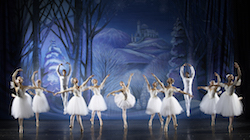
José Mateo Ballet Theatre in ‘The Nutcracker’. Photo by Gary Sloan.
Also quite artful was the overall aesthetic of Waltz of the Flowers. The Flowers were in three groups — of purple, rose and yellow costumes. This choice opened up many visual opportunities, as different colors intersected and separated in formations. DewDrop (Patricia Chang) wore a lovely Empire dress, consistent with the simple yet aesthetically graceful costuming of the whole show. The use of inner and outer circles continued into this concluding part of the show, which, along with the various colors, created a whole garden of well-curated flowers. Each danced like she was the prettiest flower of all, simply because each moved like a one-of-a-kind beauty. Each was. Similar to Ganther’s Snow Queen, yet in her own movement signature, Bonn’s Sugar Plum Fairy offered strong precision, yet a lightness simply in her ease at it.
We live in a world of ads, “snaps”, “like”, “lol” and a constant onslaught of media images. Our modern world has revolutionized the way we communicate, connect and view our world. There is value in every so often returning to worlds that are beautiful in the ways that beauty was once determined — harmony of aesthetic elements, understatement and artistic command. José Mateo Ballet Theatre offered such a world through the treasured holiday tradition of The Nutcracker. Those who had the joy of experiencing this world surely won’t forget it soon…and will look forward to returning as temperatures drop, Menorahs go up and Christmas carols commence.
By Kathryn Boland of Dance Informa.


